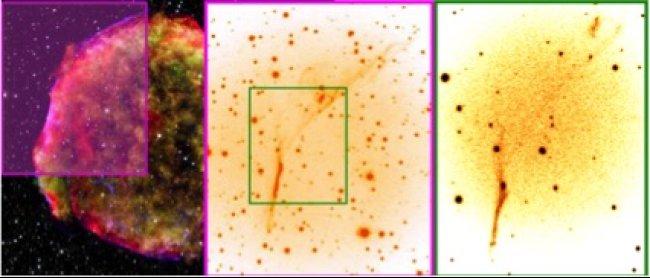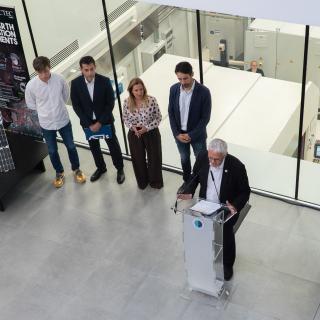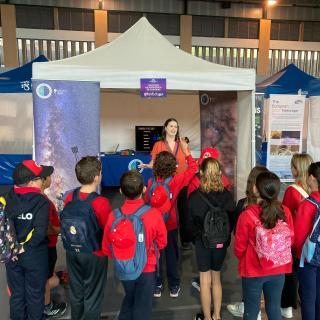Left. Composite image of the remnant of Tycho Brahe’s supernova (1572) using data from the Chandra x-ray satellite observatory (yellow, green, blue (credits NASA/SAO), from the Spitzer infrared satellite observatory (red, credits, NASA/JPL-Caltech), and
In November 1572 a supernova explosion was observed in the direction of the constellation of Cassiopeia, and its most famous observer was Tycho Brahe, one of the founders of modern observational astronomy. The explosion produced an expanding cloud of superhot gas, a supernova remnant which was rediscovered in 1952 by British radioastronomers, confirmed by visible photographs from Mount Palomar observatory, California, in the 1960’s, and a spectacular image was taken in X-rays by the Chandra satellite observatory in 2002 (see accompanying image). Astronomers use supernova remnants to explore high energy physics in interstellar space.
In an article to be published in the Astrophysical Journal a team from 7 countries, including researchers at the Instituto de Astrofísica de Canarias (IAC), has observed the Tycho supernova remnant with GHaFaS, a sophisticated instrument from the IAC, mounted on the 4.2m William Herschel Telescope (WHT) at the Roque de los Muchachos Observatory (Garafía, La Palma, Canary Islands). Their aim was to explore the hypothesis that the cosmic rays, high energy sub-atomic particles which continually bombard the Earth’s outer atmosphere, originate in these highly energetic gas clouds. GHaFaS allows astronomers to observe the emission from ionized hydrogen across wide fields, giving a map of the velocity structure within an object in fine detail.
They mapped a sizeable portion of the Tycho remnant cloud, including a prominent bright filament, and showed that the hydrogen line emitted from the filament shows a much bigger spread of velocities than can be explained from the temperature of the gas. In fact they measured two components of emission, one with a large velocity spread, and another with an even larger spread. They showed that the only way for the emission to show these characteristics is if there is a mechanical mechanism in the cloud producing high energy particles. Supernova remnants have long been considered a probable source of the cosmic rays which pour onto the outer atmosphere of the Earth, but this is the first time that clear evidence for an acceleration mechanism has been produced. Cosmic rays have energies much higher than those produced in even the biggest particle accelerators on Earth (such as CERN), and their study is important not only for astrophysics but for particle physics.
“These results could not have been produced by any of the other spectrographs on major telescopes in the world” says Joan Font, one of the authors of the article, and the person responsible for the operations of GHaFaS. “Our instrument has a unique combination of high velocity resolution, wide field, and good angular resolution, and this combination was required for the Tycho project”. These observations are a first step towards a fuller understanding of the cosmic ray acceleration mechanism in supernova remnants. “We should be able to combine these results with observations already taken using the OSIRIS narrow band imager on the 10.4m Gran Telescopio CANARIAS (GTC) to determine the efficiency of acceleration of the cosmic rays” says John Beckman, another IAC researcher and a co-author on the paper.
Article: “Balmer filaments in Tycho’s supernova remnant: an interplay between cosmic-ray and broad-neutral precursors”. Sladjana Knežević et al 2017 ApJ 846 167
https://doi.org/10.3847/1538-4357/aa8323
Contact:
Joan Font: jfont [at] iac.es (jfont[at]iac[dot]es)
John Beckman: jeb [at] iac.es (jeb[at]iac[dot]es)



